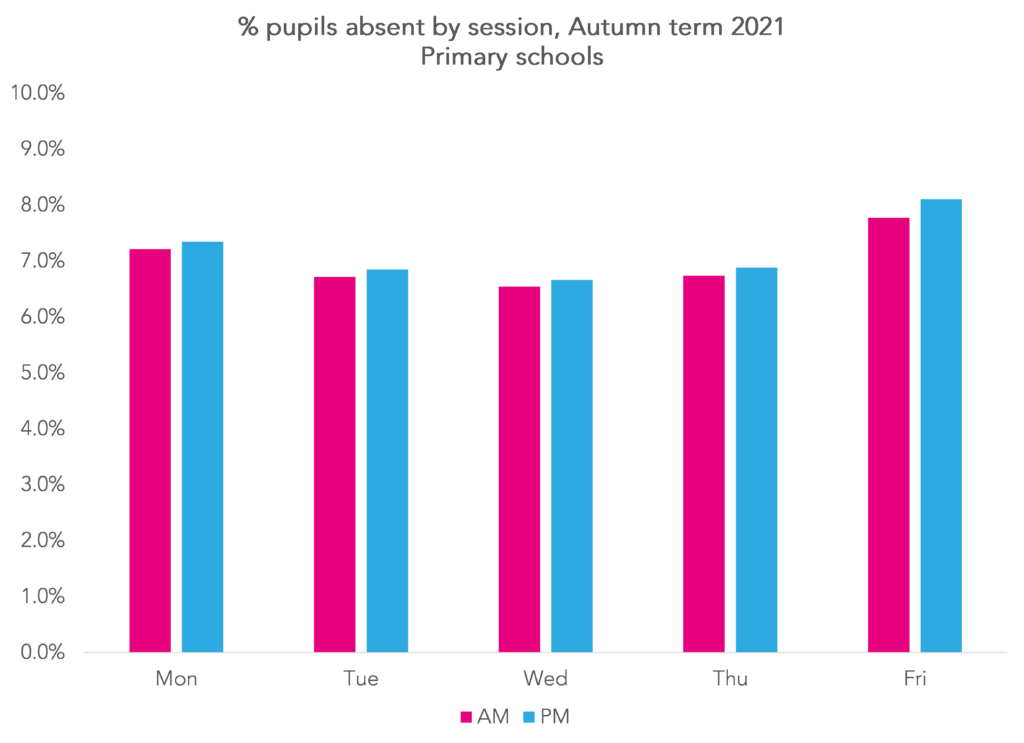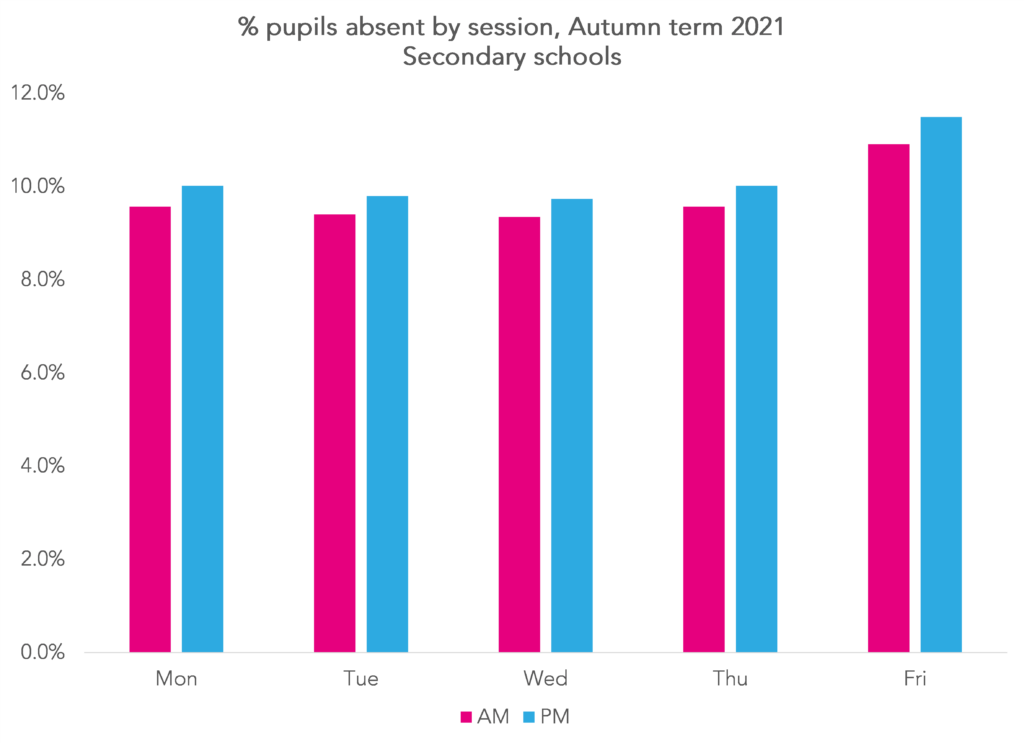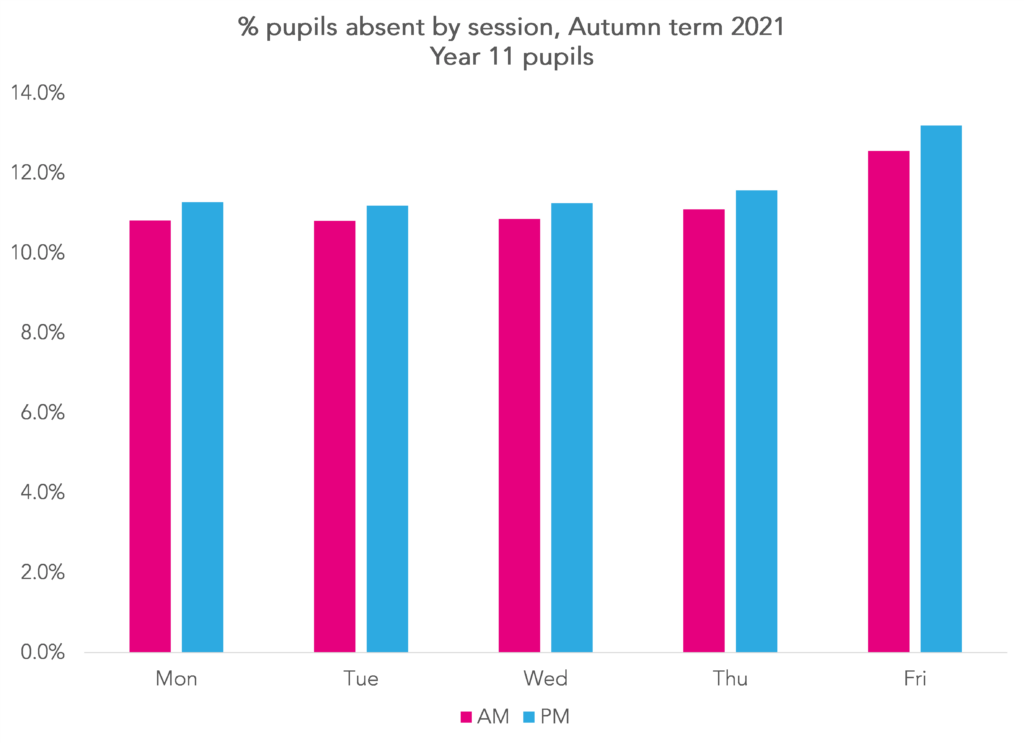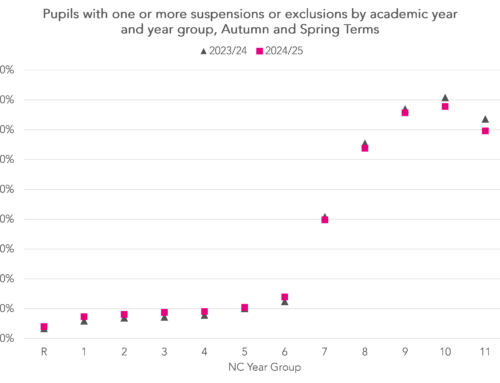Aspire Attendance Tracker
Schools can track, analyse and compare their attendance data against 1,000s of other FFT schools using Aspire Attendance Tracker.
Log in to Aspire to access Attendance Tracker – log in here.
Not an FFT Aspire user? Learn more here.
We’ve been collecting data from schools on pupil absence since the start of pandemic.
This has enabled us to show up-to-date data about absence and how it varies between year groups, regions and different groups of pupils.
But we haven’t previously shown how it varies during the week.
Absence in the autumn term
We collected data about absence in the autumn term 2021 from over 5,500 primary schools and 2,500 secondary schools.
The chart below shows how absence varied from week to week in the primary phase (Years 1 to 6) and the secondary phase (Years 7 to 11).
In general, absence tended to increase from the beginning to end of each half-term, particularly in the final week[1]. However, a dip in absence can be seen in early October, particularly in secondary. Absence fell markedly after the half term break.
How absence varies during the week
Now let’s take a look at how absence varies during each week.
In the charts below, for primary and secondary schools separately, we show absence over the whole term [2] for morning and afternoon sessions for each day of the week.
Both charts exhibit similar patterns. Absence tends to be lowest on Wednesday mornings and highest on Friday afternoons. Absence tends to be slightly higher in the afternoon than in the morning, perhaps consistent with sending home pupils showing signs of illness.
Across the term as a whole, and compared to Wednesday mornings, absence in primary schools was 1.2 percentage points higher on Friday mornings and 1.6 percentage points higher on Friday afternoons.
In secondary schools, the equivalent figures were 1.6 percentage points for Friday mornings and 2.1 percentage points for Friday afternoons.
Among Year 11 pupils, who will finish their GCSEs in the summer, the same broad patterns are apparent.
Absence day by day
Finally, and again leaving aside the final week of term[1], we look at how absence varied each day during the term.
These show that absence was highest on the final day of the October half term in both primary and secondary schools. The data may be affected by some schools finishing early for the term.
In secondary schools, the absence rate was highest on Friday afternoons every week of term apart from the first week shown. Staggered starts may affect the data for the start of this week.
In primary schools, although the rate of absence each week tended to be highest on Friday afternoons this was not the case in weeks ending 5th November (the first week after half-term for most schools) and 3rd December. In these weeks, absence was highest on Monday afternoons.
Persistent absentees
We’ve looked at persistent absence in previous blogposts. Defining it has become more challenging due to COVID.
But we can now look at pupils who are repeatedly absent for a particular session each week.
We calculate the percentage of sessions (AM and PM) missed by each pupil for each day of the week.
In the chart below, we show the percentage of pupils who have missed at least 50% of sessions they were expected to attend [3]. Some pupils, for instance those who are dual-rolled, are not necessarily expected to attend every session.
1.1% of pupils missed at least 50% of sessions every day of the week over the whole term. Although this sounds like a small amount, it still equates to 40,000 to 50,000 pupils in the full national population of secondary age pupils.
Apart from Fridays, 2% to 3% of pupils missed over half of sessions on other days of the week. This increased to between 3% and 4% on Fridays.
Disadvantaged pupils are 3.5 to 4 times more likely than other pupils to repeatedly miss a particular session during the week.
Summing up
Absence in schools tends to be higher on Fridays.
This is probably no surprise to anyone. It’s undoubtedly the case in workplaces up and down the country as well.
It is questionable whether there’s any benefit in trying to improve attendance during a pandemic. But if there is, then improving it on Fridays may be the place to start.
[1] It may be that the final week is affected by some schools/ year groups in schools finishing before Friday 17th.
[2] I leave out the week ending 3rd September due to staggered starts and the week ending 17th December for the reason above.
[3] We restrict our analysis to pupils on roll for the whole term, i.e. we ignore pupils who join or leave a school during the term













“Absence in schools tends to be higher on Fridays.
This is probably no surprise to anyone. It’s undoubtedly the case in workplaces up and down the country as well. We’re no strangers to taking it easy on a Friday afternoon.”
Horrendous presumptive and unnecessarily flippant conclusion here.
Attendance difficulties are not to be laughed at. Burn out, overwhelm, fatigue and anxiety all build throughout the week for many vulnerable children and young people for a whole host of reasons.
Having a lack of capacity or resilience is a tragedy, not a choice. For heavens sake FFT. Please try to frame your comments in a more compassion-focussed, informed, understanding and considered way.
If you’d like to understand the scale and breadth of the reasons for absence, speak to those with lived experience.
Hi Ellie. Thanks for taking the time to comment. You’re right to challenge us and it is noted. Our aim here was simply to measure what was happening without getting into questions of why (which are not apparent from the data). It was a throwaway comment about us to lighten the piece rather than offering a serious explanation of why so much repeated absence occurs.